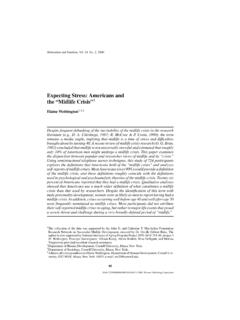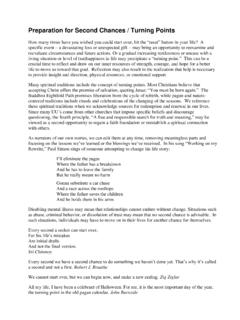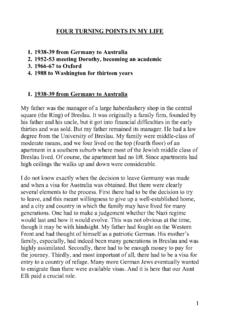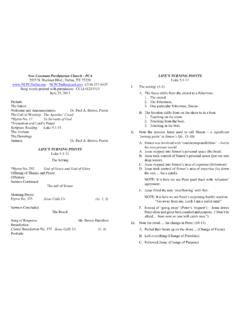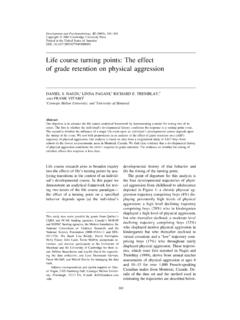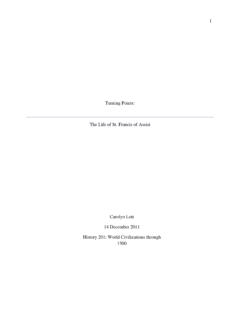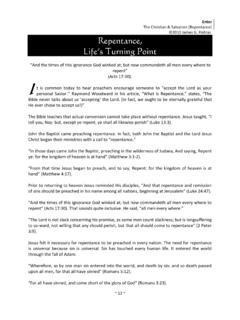Transcription of Turning Points in Christian History
1 Turning Points IN Christian HISTORYI ntroduction and the Fall of JerusalemOrganizational Information Please fill out Course Registration forms. Any Volunteers? We are looking for people to help out with setting up coffee and refreshments prior to class as well as assisting with clean up after class. We are looking for people to sign up to bring refreshments each Context of this Class at Grace 4 Pillars Christian History Biblical Doctrine Deeper Discipleship Compassion/Justice The Grace Chapel Christian History Series Turning Points in Church History A Cloud of Witnesses: History of the Early Church Christian History in America The ReformationMajor Topics of the Course The Fall of Jerusalem Empires, Doctrine, and Politics Monasticism The Culmination of Christendom East-West Schisms Protestantism A New Europe Catholicism The Wesleys Changing Face of Modern Missions The Rise of Latin American Christianity Discontents of the Modern Further Turning Points Wrap-up and ApplicationMajor Themes of the Course A Faith for All the World Defining Doctrine amidst Changing Cultures God and Caesar: Empires, Politics, and Faith A People s Faith: Christianity among the Poor, Dispossessed, Women, and Cultural Minorities The Church Universal: Diverse and Renewing A God on the Move.
2 With Imperfect FollowersOrganizational Principles Why Turning Points ? Use the latest scholarship from both secular and Christian sources to examine major Turning Points in Christian History . Make use of primary source documents to illustrate key aspects of that History . Combine lecture with small and large group discussion of key ideas. Use a Biblical world view consistent with the Grace Chapel statement of faith to inform instruction. Suggest practical application of this material in our lives as believers kingdom QuestionI can only answer the question, What am I to do? if I can answer the prior question, Of what story or stories do I find myself a part. Alasdair MacIntyreIf someone were to ask you what is the story (or History ) of Christianity, how would you answer them?
3 The Fall The First Jewish Revolt began in Caesarea in the year 66. By 68, the Roman general Vespasian began marching toward Jerusalem. In 69 Vespasian returned to Rome to become Emperor. His son Titus took over the campaign. After several months of siege Jerusalem was captured and the temple destroyed in 70. Three years later in 73, the First Jewish Revolt ended with the capture of the mountain fortress at 21: 20-24 20 When you see Jerusalem being surrounded by armies,you will know that its desolation is let those who are in Judea flee to the mountains, let those in the city get out, and let those in the country not enter the this is the time of punishmentin fulfillmentof all that has been dreadful it will be in those days for pregnant women and nursing mothers!
4 There will be great distress in the land and wrath against this will fall by the sword and will be taken as prisoners to all the nations. Jerusalem will be trampledon by the Gentiles until the times of the Gentiles are fulfilled. The Siege and Destruction of Jerusalem, by David Roberts (1850)Josephus Account What strikes you about Josephus account of the Fall of Jerusalem? What impact do you think such an event would have on cultures that were centered around Jerusalem? Are there any contemporary events that might be parallels with the fall of Jerusalem?The Goal of the Romans Titus goal according to SulpiciusSeverus to eradicate the temple in order that the Jewish and Christian religions might more completely be abolished; for although these religions were mutually hostile, they had nevertheless sprung from the same founders; the Christians were an offshoot of the Jews, and if the root were taken away the stock would easily perish.
5 Bruce In the lands outside Palestine, the decade which ended with the year 70 marked the close of the period when Christianity could be regarded as simply a variety of From 70 onward the divergence of the paths of Jewish Christianity and orthodox Judaism was Henceforth the main stream of Christianity must make its independent way in the Gentile world. -F. F. BruceDr. Marvin Wilson The First Jewish Revolt marked a Turning point in the History of Judaism. The early Church up to 70 was a daughter of Judaism: only after that did it leave the nest .. But the date of 70 basically marked the end of the Zealot, Sadducean, and Essene sects. Only the Pharisees and the struggling Nazarenes remained as parties in major contention.
6 -Marvin Wilson quoting W. D. DaviesThe Challenge of Early Diversity Tension and struggle seen within the New Testament See Galatians 2:11-14 Bart Ehrmanand Elaine Pagels Many Gnostic and other early Christian groups existed. Many Gnostic Gospels contain anti-Semitic, mysogenist, and anti-incarnational Interpretations Little evidence from 70 to 110. How do we fill in the gaps? Roman Catholic emphasize the role of Bishops and look for evidence of apostolic succession. Eastern Orthodox focus on common patterns of prayer, scripture use, and consensus. Protestant stress the foundation of Scripture and question human institutions, more critical of the early church. Canon Canon Standard or Rule First used In 367 by Athanasius to describe the authoritative list of books in the Bible.
7 In the post-Apostolic Age, the Church needed to define which writings were Scripture. The Canon provided: Standards for worship, models for prayers, liturgies, and sermons. Devotional reading material for both public and private use. A theological standard for responding to non-Christians and heretics. Aselect list of sacred books based on the Jewish Model 2 Peter 3:15-16 just as our dear brother Paul also wrote you with the wisdom that God gave him. He writes the same way in all his letters, speaking in them of these matters. Canon II By about 100 Pauline letters and collections of Gospels were circulating. Marcionproposed the first Canon in 144. (later heretical) By the year 200, the MuratonianCanon was close to, but not exactly, like the recognized New Testament.
8 The final Canon was in place by the end of the fourth century attested by Bishop Athanasius in 367 and a synod in Carthage in 397. 1& 2 Peter, James, Hebrews, 2&3 John and Revelation were long disputed. Wisdom of Solomon, Apocalypse of Peter, (Pauline letters to Laodicea and Alexandria), and Shepherd of Hermas The key criteria was apostolicity. But ..Episcopacy Church Leadership was fluid in the New Testament by the mid 60s there are Bishops, Deacons, Presiding Officers, and Elders (Precise roles not clearly defined) See Acts 14:23, 1 Timothy 3, and 5, and Titus 1:5 In 112 Ignatius urged believers to follow the bishop as Jesus Christ followed the Father. Bishop s approval needed for Baptism and Communion Irenaeus in 185 began claiming unbroken apostolic succession.
9 Cyprian of Carthage The bishop is in the Church and the Church is in the bishop, and that if anyone be not with the bishop he is not in the Church. Episcopacy II Matt 16:18 And I tell you that you are Peter, and on this rock I will build my church Church organization was based on the model of synagogues. The episcopal organization of the church also transcended Jewish models. Bishops moderated the internal life of the Church and organized its response to the world. Creed Short statements of belief summarized Christian teaching and introduced seekers to the faith. Baptismal Creeds prepared converts for baptism. Councilar Creeds promulgated by the great councils of the Church More Next Week The New Testament shows references to short statements of belief 1 Cor15:3-5 For what I received I passed on to you as of first importance: that Christ died for our sins according to the Scriptures, that he was buried, that he was raised on the third day according to the Scriptures, and that he appeared to Peter, and then to the Twelve.
10 Used for worship and to defend against heresy. (Bolster belief and inoculate against heresy.)Ignatius of Antioch s Creed ( ) Turn a deaf ear to any speaker who avoids mention of Jesus Christ who was of David s line, born of Mary, who was truly born, ate and drank; was truly persecuted under Pontius Pilate, truly crucified and died while those in heaven, on earth, and under the earth beheld it; who also was truly raised from the dead, the Father having raised him, who in like manner will raise us also who believe in Him His Father, I say, will raise us in Christ Jesus, apart from whom we have not true life . Steps for a Growing Church Turning Point at 70 The Church s emergence from its Jewish roots. Define Scripture, Organizational Structure, and Doctrine as a foundation for growth and expansion.

